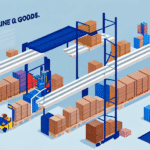Understanding Delivery Metrics: Measuring Success in Supply Chain Management
In today's fast-paced business environment, delivery metrics play a crucial role in measuring the success and efficiency of supply chain operations. These metrics provide businesses with the insights needed to optimize delivery processes, enhance customer satisfaction, and maintain a competitive edge. This comprehensive guide explores the key delivery metrics, their importance, and best practices for leveraging them to boost business performance.
Importance of Delivery Metrics for Business Success
Delivery metrics are essential for evaluating the effectiveness of supply chain management. By systematically tracking these metrics, businesses can identify inefficiencies, reduce costs, and improve overall service quality. Reliable delivery performance not only meets customer expectations but also fosters loyalty and drives repeat business.
Key Benefits of Tracking Delivery Metrics
- Operational Efficiency: Identifying bottlenecks to streamline processes.
- Cost Reduction: Optimizing routes and reducing unnecessary expenses.
- Customer Satisfaction: Ensuring timely and accurate deliveries to enhance customer experience.
- Competitive Advantage: Maintaining superior delivery performance compared to competitors.
Essential Delivery Metrics to Monitor
Tracking the right delivery metrics is vital for gaining actionable insights. Below are the most important metrics businesses should monitor:
1. Delivery Time
Measures the duration from order placement to delivery. Reducing delivery time can significantly improve customer satisfaction. According to a Forbes article, faster delivery times correlate strongly with higher customer retention rates.
2. Delivery Accuracy
Represents the percentage of orders delivered correctly and on time. High delivery accuracy minimizes returns and enhances trust. Industry reports from ShipHype indicate that accuracy rates above 98% are ideal for maintaining customer satisfaction.
3. Delivery Cost
Calculates the total cost associated with the delivery process, including transportation, labor, and packaging. Businesses can reduce delivery costs by optimizing routes and negotiating better rates with carriers.
4. Delivery Frequency
Tracks the number of deliveries made within a specific timeframe. Increasing delivery frequency can enhance service levels but must be balanced against potential cost increases.
Selecting the Right Delivery Metrics for Your Business
Choosing the appropriate delivery metrics depends on your business goals, industry standards, and customer expectations. Consider the following factors when selecting metrics:
Align with Business Objectives
Ensure that the metrics you choose directly support your overall business goals, such as expanding market share or improving customer loyalty.
Industry Standards
Benchmark your metrics against industry standards to identify areas where your performance can be improved.
Customer Expectations
Understand what your customers value most in delivery services, whether it's speed, accuracy, or cost, and prioritize metrics accordingly.
Top Tools for Measuring Delivery Metrics
Utilizing the right tools is essential for accurately tracking and analyzing delivery metrics. Here are some of the leading tools in the market:
Enterprise Resource Planning (ERP) Software
ERP systems integrate various business processes, providing real-time data and comprehensive reporting capabilities to monitor delivery performance.
Transportation Management Systems (TMS)
TMS software helps optimize shipping routes, manage carrier relationships, and track deliveries in real-time, enhancing overall delivery efficiency.
GPS Tracking Software
Real-time GPS tracking allows businesses to monitor the location of their shipments, predict delivery times accurately, and respond proactively to delays.
Customer Relationship Management (CRM) Software
CRM systems track customer interactions and feedback, offering insights into delivery performance and areas for improvement.
Best Practices for Improving Delivery Metrics
Enhancing your delivery metrics requires a strategic approach. Implement the following best practices to optimize your delivery processes:
Regularly Review and Update Metrics
Continuously assess your delivery metrics to ensure they remain relevant and aligned with your business goals. Adjust them as needed to reflect changing market conditions and customer expectations.
Invest in Technology
Adopt advanced technologies such as AI and machine learning to analyze delivery data, predict potential issues, and automate process improvements.
Optimize Delivery Routes
Use route optimization tools to reduce delivery times and costs. Efficient routing not only saves money but also improves delivery reliability.
Enhance Order Fulfillment Processes
Streamline your order processing and fulfillment procedures to increase delivery accuracy and reduce the likelihood of errors.
Future Trends in Delivery Metrics
The landscape of delivery metrics is continually evolving with advancements in technology. Here are some emerging trends to watch:
Artificial Intelligence and Machine Learning
AI and machine learning are transforming delivery metrics by providing predictive analytics and deeper insights into delivery performance.
Real-Time Data Analytics
Real-time data allows businesses to make immediate adjustments to their delivery processes, enhancing responsiveness and efficiency.
Integration with IoT Devices
IoT devices provide granular data on shipment conditions and locations, enabling more precise tracking and improved delivery accuracy.
Conclusion
Delivery metrics are indispensable for businesses aiming to optimize their supply chain management and achieve sustained success. By carefully selecting and diligently tracking the right metrics, leveraging advanced tools, and adhering to best practices, businesses can enhance their delivery performance, reduce costs, and exceed customer expectations. Staying informed about future trends ensures that your delivery strategies remain cutting-edge, fostering long-term growth and competitiveness in the market.




















